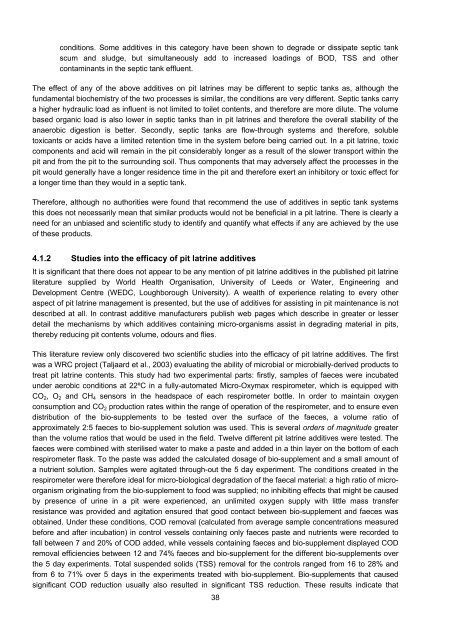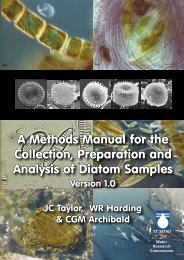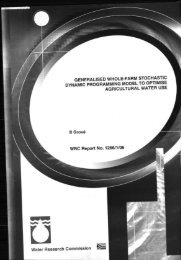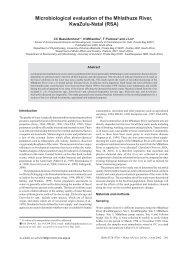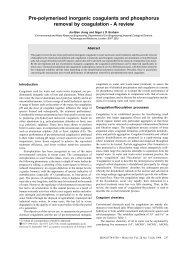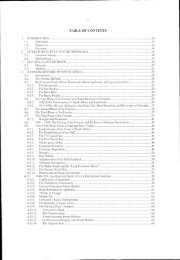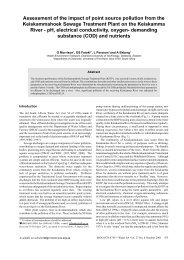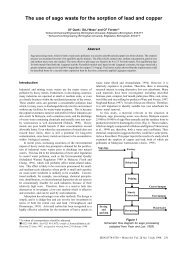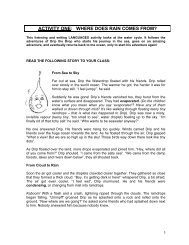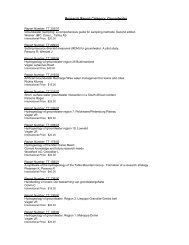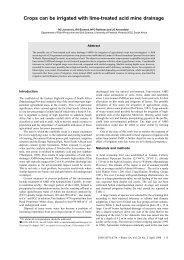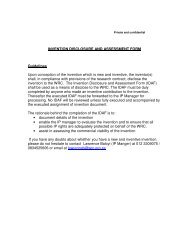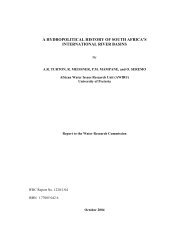and the Efficacy of Pit Latrine Additives - Water Research Commission
and the Efficacy of Pit Latrine Additives - Water Research Commission
and the Efficacy of Pit Latrine Additives - Water Research Commission
- No tags were found...
Create successful ePaper yourself
Turn your PDF publications into a flip-book with our unique Google optimized e-Paper software.
conditions. Some additives in this category have been shown to degrade or dissipate septic tank<br />
scum <strong>and</strong> sludge, but simultaneously add to increased loadings <strong>of</strong> BOD, TSS <strong>and</strong> o<strong>the</strong>r<br />
contaminants in <strong>the</strong> septic tank effluent.<br />
The effect <strong>of</strong> any <strong>of</strong> <strong>the</strong> above additives on pit latrines may be different to septic tanks as, although <strong>the</strong><br />
fundamental biochemistry <strong>of</strong> <strong>the</strong> two processes is similar, <strong>the</strong> conditions are very different. Septic tanks carry<br />
a higher hydraulic load as influent is not limited to toilet contents, <strong>and</strong> <strong>the</strong>refore are more dilute. The volume<br />
based organic load is also lower in septic tanks than in pit latrines <strong>and</strong> <strong>the</strong>refore <strong>the</strong> overall stability <strong>of</strong> <strong>the</strong><br />
anaerobic digestion is better. Secondly, septic tanks are flow-through systems <strong>and</strong> <strong>the</strong>refore, soluble<br />
toxicants or acids have a limited retention time in <strong>the</strong> system before being carried out. In a pit latrine, toxic<br />
components <strong>and</strong> acid will remain in <strong>the</strong> pit considerably longer as a result <strong>of</strong> <strong>the</strong> slower transport within <strong>the</strong><br />
pit <strong>and</strong> from <strong>the</strong> pit to <strong>the</strong> surrounding soil. Thus components that may adversely affect <strong>the</strong> processes in <strong>the</strong><br />
pit would generally have a longer residence time in <strong>the</strong> pit <strong>and</strong> <strong>the</strong>refore exert an inhibitory or toxic effect for<br />
a longer time than <strong>the</strong>y would in a septic tank.<br />
Therefore, although no authorities were found that recommend <strong>the</strong> use <strong>of</strong> additives in septic tank systems<br />
this does not necessarily mean that similar products would not be beneficial in a pit latrine. There is clearly a<br />
need for an unbiased <strong>and</strong> scientific study to identify <strong>and</strong> quantify what effects if any are achieved by <strong>the</strong> use<br />
<strong>of</strong> <strong>the</strong>se products.<br />
4.1.2 Studies into <strong>the</strong> efficacy <strong>of</strong> pit latrine additives<br />
It is significant that <strong>the</strong>re does not appear to be any mention <strong>of</strong> pit latrine additives in <strong>the</strong> published pit latrine<br />
literature supplied by World Health Organisation, University <strong>of</strong> Leeds or <strong>Water</strong>, Engineering <strong>and</strong><br />
Development Centre (WEDC, Loughborough University). A wealth <strong>of</strong> experience relating to every o<strong>the</strong>r<br />
aspect <strong>of</strong> pit latrine management is presented, but <strong>the</strong> use <strong>of</strong> additives for assisting in pit maintenance is not<br />
described at all. In contrast additive manufacturers publish web pages which describe in greater or lesser<br />
detail <strong>the</strong> mechanisms by which additives containing micro-organisms assist in degrading material in pits,<br />
<strong>the</strong>reby reducing pit contents volume, odours <strong>and</strong> flies.<br />
This literature review only discovered two scientific studies into <strong>the</strong> efficacy <strong>of</strong> pit latrine additives. The first<br />
was a WRC project (Taljaard et al., 2003) evaluating <strong>the</strong> ability <strong>of</strong> microbial or microbially-derived products to<br />
treat pit latrine contents. This study had two experimental parts: firstly, samples <strong>of</strong> faeces were incubated<br />
under aerobic conditions at 22ºC in a fully-automated Micro-Oxymax respirometer, which is equipped with<br />
CO 2 , O 2 <strong>and</strong> CH 4 sensors in <strong>the</strong> headspace <strong>of</strong> each respirometer bottle. In order to maintain oxygen<br />
consumption <strong>and</strong> CO 2 production rates within <strong>the</strong> range <strong>of</strong> operation <strong>of</strong> <strong>the</strong> respirometer, <strong>and</strong> to ensure even<br />
distribution <strong>of</strong> <strong>the</strong> bio-supplements to be tested over <strong>the</strong> surface <strong>of</strong> <strong>the</strong> faeces, a volume ratio <strong>of</strong><br />
approximately 2:5 faeces to bio-supplement solution was used. This is several orders <strong>of</strong> magnitude greater<br />
than <strong>the</strong> volume ratios that would be used in <strong>the</strong> field. Twelve different pit latrine additives were tested. The<br />
faeces were combined with sterilised water to make a paste <strong>and</strong> added in a thin layer on <strong>the</strong> bottom <strong>of</strong> each<br />
respirometer flask. To <strong>the</strong> paste was added <strong>the</strong> calculated dosage <strong>of</strong> bio-supplement <strong>and</strong> a small amount <strong>of</strong><br />
a nutrient solution. Samples were agitated through-out <strong>the</strong> 5 day experiment. The conditions created in <strong>the</strong><br />
respirometer were <strong>the</strong>refore ideal for micro-biological degradation <strong>of</strong> <strong>the</strong> faecal material: a high ratio <strong>of</strong> microorganism<br />
originating from <strong>the</strong> bio-supplement to food was supplied; no inhibiting effects that might be caused<br />
by presence <strong>of</strong> urine in a pit were experienced, an unlimited oxygen supply with little mass transfer<br />
resistance was provided <strong>and</strong> agitation ensured that good contact between bio-supplement <strong>and</strong> faeces was<br />
obtained. Under <strong>the</strong>se conditions, COD removal (calculated from average sample concentrations measured<br />
before <strong>and</strong> after incubation) in control vessels containing only faeces paste <strong>and</strong> nutrients were recorded to<br />
fall between 7 <strong>and</strong> 20% <strong>of</strong> COD added, while vessels containing faeces <strong>and</strong> bio-supplement displayed COD<br />
removal efficiencies between 12 <strong>and</strong> 74% faeces <strong>and</strong> bio-supplement for <strong>the</strong> different bio-supplements over<br />
<strong>the</strong> 5 day experiments. Total suspended solids (TSS) removal for <strong>the</strong> controls ranged from 16 to 28% <strong>and</strong><br />
from 6 to 71% over 5 days in <strong>the</strong> experiments treated with bio-supplement. Bio-supplements that caused<br />
significant COD reduction usually also resulted in significant TSS reduction. These results indicate that<br />
38


